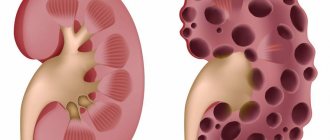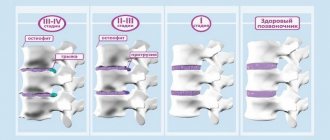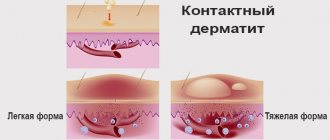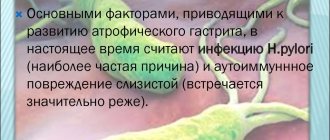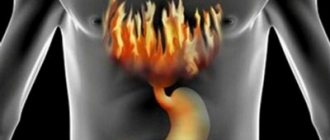Updated: March 4, 2020, at 16:02
According to statistics, approximately 60% of adults in the world suffer from disorders of the digestive system. Pathologies are accompanied by unpleasant symptoms: nausea, vomiting, pain of varying intensity, and bowel disorders. With gastritis, an inflammatory process develops in the mucous layer of the stomach, leading to dangerous complications if left untreated. This article describes in detail what gastritis is, what its symptoms are and how treatment is carried out in adults.
Description
The stomach is the most vulnerable part of the gastrointestinal tract, in which three digestive processes occur:
- the food ball is mechanically mixed;
- food is chemically broken down;
- nutrients are absorbed.
Most often, the inner lining of the stomach wall is damaged - the mucous layer, where mutually exclusive components of digestion are produced: gastric juice and protective mucus.
Gastritis is a long-term disease of the stomach in which inflammatory or degenerative changes occur in the mucous tissues of the walls of the organ. The progression of the pathology disrupts regenerative functions, atrophy of epithelial cells develops, and normal glands are replaced by fibrous tissue. The main functions of the stomach are disrupted, primarily secretory.
Causes of stomach diseases
Most often, stomach diseases are associated with inflammation of the mucous membrane, which lines the walls of the stomach and protects it from various harmful factors.
The glands of the stomach produce hydrochloric acid, which helps digest food. Normally, after gastric juice breaks down food, useful substances enter the blood, and everything unnecessary is eliminated from the body.
Often, due to a poor diet or due to infection with the bacterium Helicobacter pylori , gastric juice becomes more acidic and irritates the gastric mucosa, which can result in acute gastritis.
At this time, the patient experiences severe pain, vomiting mixed with bile and mucus, a burning sensation in the epigastric region of the stomach, blood pressure decreases, and arrhythmia appears.
Types of gastritis
There are two main forms of gastritis:
- Acute, caused by exposure to aggressive irritants (for example, spicy food, alcohol intoxication, etc.).
- Chronic, when the development of inflammation is provoked by increased stomach acidity and Helicobacter pylori infection. Characterized by periods of remission and exacerbation.
Based on the secretion of gastric juice, gastritis is divided into:
- hyperacid (with an increased level of acidity);
- hypoacid (with a reduced level of acidity).
Why does the stomach become inflamed?
The stomach contains an aggressive environment: gastric juice is hydrochloric acid and enzymes. At the same time, the organ does not digest itself: the acid does not have access to the lining of the stomach, protected by a layer of mucus. Only those areas where this layer is destroyed are exposed to the aggressive effects of gastric juice.
In addition to external influences, internal factors can affect the condition of the stomach - for example, there is autoimmune gastritis. Acute inflammation can develop due to a viral infection and usually resolves quickly without requiring treatment.
Causes of gastritis
The development of gastritis in adults can be triggered by external and internal reasons. The most common external factors:
- infection of the stomach walls by pathogenic fungi or bacteria;
- unhealthy irregular diet;
- smoking and alcohol abuse;
- long-term use of certain medications (antibiotics, aspirin, hormonal agents);
- helminthic infestations;
- stress;
- harmful working conditions (contact with chemicals, etc.).
The main internal causes of gastritis:
- hereditary predisposition to gastrointestinal diseases;
- duodenal reflux;
- disruption of protective immune functions in cells;
- hormonal disorders;
- allergic diseases;
- reflex transmission of pathogenesis from adjacent organs.
First signs
Initially, the disease leads to the following symptoms:
- significant discomfort (distension or compression) in the upper part of the peritoneum after eating;
- periodic pain in the same area;
- heartburn;
- belching with a sour taste;
- whitish coating on the tongue;
- a slight increase in temperature (it stays at around 37);
- dyspepsia (vomiting, diarrhea, nausea).
Of course, these same symptoms accompany any poisoning.
But the presence of several of the signs described above requires a mandatory visit to a specialist (in this case, a gastroenterologist).
It is important to understand, no matter how acute gastritis is, it is only the first sign. It will most likely be followed by other more serious ailments:
- stomach ulcer;
- cancer.
Thus, timely treatment of the disease will guarantee that the above problems can be completely avoided.
Symptoms of gastritis
Gastritis has a variety of manifestations, and can occur without pronounced symptoms. The first, most characteristic sign of this gastropathology is:
- Feeling of pain in the solar plexus.
- The pain may intensify after consuming liquids, foods or medications that aggressively affect the gastric mucosa.
- The pain may intensify between meals.
The symptoms of gastritis depend on the form of the pathology:
| Form of gastritis | Symptoms |
| Acute |
|
| Chronic |
|
| With increased acidity |
|
| With reduced acidity |
|
In addition, common symptoms of gastritis are:
- fatigue, weakness;
- dizziness;
- sudden weight loss;
- disorders of the cardiovascular system;
- irritability;
- drowsiness.
Why doesn't everyone get sick?
What new things have we been able to discover about Helicobacter in the nearly 35 years that we have known about it? The biggest news: 50-60% of people on the planet are infected with it! It’s clear why not every one of them gets sick: after all, even the flu virus doesn’t kill everyone, but only people with weakened immune systems.
You cannot change your character, but you can, with the help of appropriate training, teach yourself to think positively. Without a positive attitude, even after a successful course of antibiotics, the bacterial agent 007 returns to the stomach! And if you change your mind in a positive way, you can get rid of Helicobacter after the first antibiotic therapy.
Diagnosis of gastritis
A therapeutic diet helps to successfully treat gastritis at home.
Diagnosis of gastritis consists of several stages:
- Analysis of patient complaints, collection of a detailed medical history, visual examination.
- General and biochemical blood test.
- Analysis of urine.
- Stool tests for blood and for the presence of Helicobacter pylori infection.
- Endoscopy with biopsy. The following are determined: the presence of the bacterium Helicobacter pylori, the characteristics of inflammation of the gastric mucosa, the presence/absence of precancerous changes. For biopsy, at least five samples of mucous tissue are taken (2 fragments from the antrum, 2 from the body of the organ, 1 from the angle of the stomach).
- Breath test. Determines the presence of Helicobacter pylori.
- Intragastric pH-metry. Determines the level of secretory functions and diagnoses functional disorders.
- Ultrasound. The liver, gall bladder, and pancreas are examined to identify concomitant gastrointestinal diseases.
- Manometry. The upper gastrointestinal tract is examined to determine the presence or absence of reflux gastritis.
- Electrogastroenterography. The motor and evacuation functions of the gastrointestinal tract are examined to determine duodenogastric reflux.
Diagnostic methods
The examination will determine the degree of damage with high accuracy.
A medical examination will help to recognize gastritis of the stomach at the initial stage of diagnosis. At the appointment, the doctor examines the patient for signs of pain in the abdomen, learns the characteristics of the patient’s life, his diet, bad habits and family diseases. Next, the patient undergoes tests that indicate possible changes in the functioning of internal organs. To obtain detailed information about the disease, the following instrumental diagnostic methods are prescribed:
- FGS. A method for thoroughly examining the walls of the digestive organs. With its help, the degree of tissue damage and foci of inflammation are determined.
- Ultrasound. A painless examination that reveals inflammation of the walls of the stomach and duodenum.
- X-ray. The tone of the walls, their pathological changes and the appearance of inflammation are checked. It is carried out after taking a radiopaque contrast agent.
- Thermography. Helps monitor changes in the gastrointestinal tract during therapy using special equipment.
- Biopsy. Taking stomach tissue for analysis helps detect infection with Helicobacter pylori bacteria.
- Determination of acidity. The procedure is necessary to control the pH of the stomach, allowing you to choose the right treatment method.
- Identification of components of gastric juice. A method that analyzes the composition of the acid and, depending on the components found, determines the etiology of the disease and prescribes treatment.
- Electrogastroenterography. A procedure that allows you to accurately determine the pathology, check the structure of the walls of the stomach and damage to the mucosa.
When the patient has been examined, taking into account the results, the doctor prescribes treatment.
Treatment of gastritis
The goal of treating gastritis is:
- eliminate factors that provoke the inflammatory process (infection, unhealthy eating behavior, etc.);
- stimulate restoration processes in the mucous tissues of the stomach;
- to prevent exacerbations of pathology in the future.
Gastritis must be treated comprehensively using:
- Drug therapy.
- Diet.
- Traditional medicine methods.
The treatment regimen depends on the form of gastritis. For increased stomach acidity, the following medications are prescribed:
| Group of drugs | Name |
| Antibiotics |
|
| Enveloping drugs |
|
| Antisecretory agents |
|
| Antispasmodics |
|
| Cytoprotectors |
|
| Enzymatic agents |
|
| Antiemetic drugs |
|
If the acidity of the stomach is increased, the same drugs are prescribed with the exception of antacids. The secretory functions of the stomach can be stimulated with biological substitutes for hydrochloric acid, such as Pepidol and Abomin. To improve the breakdown of food mass, Pankurmen is prescribed. To prevent hypovitaminosis and anemia, multivitamin complexes are used.
If you have gastritis, you should never self-medicate. This leads to severe complications that are life-threatening. Only a gastroenterologist can prescribe competent and effective treatment.
Diet for gastritis
Nutrition depends on the form and course of the disease. In case of acute gastritis and exacerbation of chronic gastritis, a strict diet is indicated; in the remission phase of the chronic form, the diet can be expanded. For any type of illness, alcohol, smoking, fried, fatty, and spicy foods are strictly excluded. You should also never go hungry.
The patient's meals should be fractional; he needs to eat food in small portions up to 6 times a day.
Diet
A therapeutic diet helps to successfully treat gastritis at home.
First of all, you should follow the recommendations for proper eating behavior:
- Make a meal schedule and eat at the same time 5 times a day.
- You cannot take long intervals between meals.
- You should not overeat, portions should be small (up to 300 g).
- Eat slowly, chewing food thoroughly.
- It is not recommended to eat too hot or cold food; food should be warm.
- You should not eat immediately before bed. The last meal should be 3 hours before going to bed.
- The diet should be nutritious and balanced.
- Fried, fatty, spicy, salted, smoked, pickled foods are excluded.
- Minimize salt intake, eliminate spices and seasonings.
- Every day you should drink at least 1.5 liters of water (preferably still mineral water).
Therapeutic nutrition for hyperacid gastritis
For gastritis with high stomach acidity, the following products are recommended and excluded:
| Can | It is forbidden |
| Boiled lean meat (chicken, rabbit), steamed cutlets and meatballs | Fatty meat (lamb, pork, duck), sausage, sausages, canned meat |
| Lean fish (pink salmon, cod) | Rye bread, pastries |
| Boiled pureed vegetables | Salted and smoked fish |
| Semolina, oatmeal, rice porridge | Chocolate, confectionery |
| Low-fat cottage cheese, milk | Legumes, cabbage, radishes, mushrooms |
| Fruit puree, compote, jelly | Carbonated and alcoholic drinks, coffee |
For hyperacid gastritis it is useful to drink:
- milk. It reduces stomach acidity well and eliminates heartburn. However, it is not used as a remedy, only as an addition to solid food. Milk does not stay in the stomach for long and reduces acidity for a short time;
- weak warm tea;
- natural juices. Sour juices (grape, apple, orange) are excluded. It is recommended to consume juices with pulp (tomato, pear, banana, peach);
- fruit jelly. Partially neutralize excess acid. Used as an addition to the main meal;
- alkaline mineral waters. Drink 1 glass warm before meals.
Therapeutic nutrition for hypoacid gastritis
List of basic foods that can and cannot be included in the diet for hypoacid gastritis:
| Can | It is forbidden |
| Boiled chicken and rabbit meat, steamed cutlets and meatballs | Lean or fatty meat, sausages, smoked meats |
| Low-fat meat broth, fish soup | Fatty fish, canned fish |
| Milk, kefir, sour cream, cottage cheese, cheese | Beer, kvass, sweet carbonated drinks |
| Vegetable purees and salads | Butter and puff pastries |
| Natural fruit juices (except grape), compotes | Hot sauces, mayonnaise, ketchup |
| Decoction of rose hips and black currants | Hard-boiled eggs, scrambled eggs |
It is very useful to drink juice or fruit drink from rose hips, sea buckthorn, cranberries, and lingonberries. Carrot juice is good for you. You should eat berries: strawberries, raspberries, black currants, gooseberries. You can eat citrus fruits (tangerines, oranges, grapefruits) in small quantities. It is recommended to add cabbage, zucchini, pumpkin, carrots, ripe tomatoes, herbs (except onions) and cucumbers to the menu.
Video on the topic:
Algorithm of action for suspected gastritis
If you notice signs of gastritis, try to exclude any self-medication options. The optimal solution would be an emergency visit to a doctor at your place of residence. This simple and smart measure will significantly increase the chances of a quick recovery and protection from future relapses.
If you are far from home and experience mild symptoms of gastritis, wait until you return and visit a gastroenterologist in your hometown.
While there is no possibility of an in-person visit to the doctor, adhere to the following rules:
- Rationalize your diet by excluding all unhealthy foods from the menu (fast food, smoked meats, confectionery, packaged juices, sweet and unsweetened carbonated drinks, etc.);
- Give up bad habits (drinking alcohol and smoking tobacco);
- Have breakfast with oatmeal and water (without sugar or other additives);
- Drink 2 glasses of clean drinking water without gas on an empty stomach, immediately after waking up;
- Take a dessert spoon of vegetable oil every morning before breakfast;
- Drink oatmeal or milk jelly 1-3 times during the day;
- Try to make the daily menu similar to the menu of treatment table No. 1;
- Limit physical activity, leaving only walking in the fresh air.
If you have already had gastritis and now suspect an exacerbation, call your doctor and ask them to advise you on medications.
If symptoms worsen, immediately consult a doctor at your place of residence, or call a local ambulance. This algorithm is also relevant if poisoning with toxic substances is suspected.
It is advisable not to resort to “folk recipes” without diagnosis. Typically, alternative treatments for gastritis are applicable only to hyperacid forms (gastritis with high acidity), and in the hypoacid form they can aggravate the course of the pathology. It should be remembered that any such measures are acceptable as an auxiliary therapy for drug and physiotherapeutic treatment, but will not replace it.
For those who suffer from chronic gastritis, a systematic preventive examination by a doctor is recommended (1-2 times a year) and the maximum possible transition to a healthy lifestyle. This will help prevent flare-ups. Also consult a gastroenterologist if another doctor prescribes you a regimen of strong medications (NSAIDs, hormones, etc.). If there is a threat of exacerbation, it is better to adjust or change such treatment.
Simple gastritis is a relatively “safe” disease that responds well to treatment. Its other forms can negatively affect the quality of life in the future if medical assistance is ignored. Remember that timely and appropriate treatment helps protect against dangerous complications, including cancer.
Folk remedies
In combination with drug therapy in the treatment of gastritis in adults, traditional medicine recipes are widely used:
- Chicken egg white and aloe juice. The ingredients are mixed in equal proportions. The product is used 1 tbsp. lie before meals three times a day.
- Thyme tincture. 2 tbsp. lie herbs pour ½ liter of white wine. Leave in the refrigerator for a week. After this, bring the mixture to a boil and strain. Every time before meals, drink a dessert spoon of the product.
- Mumiyo. Add ¼ g of mumiyo to milk and honey. Take 50 ml in the morning before breakfast and before bed.
- Pour 100 g of wheat grains with water. After the sprouts appear, rinse the wheat and grind through a meat grinder. Add a few tablespoons of sunflower oil to the resulting mass. Use in the morning before breakfast.
- Mix sea buckthorn oil and 10% propolis tincture (1:10). Drink 20 drops three times a day, adding to milk or mineral water.
- Bird cherry fruits. Pour 1 tbsp into a glass of boiling water. lie fruits and cook for 15 minutes. After the mixture has cooled, add 40 drops of 10% alcohol tincture of propolis. Take 50 ml three times a day.
You can use traditional medicine in the treatment of gastritis only on the recommendation of your doctor. The exact dosage of the drug and the duration of the course of treatment are determined by the gastroenterologist.
Acute gastritis in children
What does acute gastritis look like in children? As in adults, the main cause of acute gastritis in children is overeating. But in relation to children, fatty foods, as well as fried, smoked and spicy foods, are especially dangerous. The child’s body reacts sharply to dry food and consumption of large amounts of carbonated drinks. The risk group in childhood includes children of early school age 6-10 years old and adolescents of transitional age 12-13 and 16-17 years old. These age groups are especially likely to experience poor nutritional conditions. Poor nutrition means children consuming fast food: hamburgers, French fries, chips, crackers, fried pies, highly carbonated drinks, smoked foods, and dishes with a high content of spices.
Violation of diet and regularity of food intake has a negative impact. Long breaks between meals and too large amounts of food create the preconditions for attacks of gastritis.
Children today are extremely busy with school responsibilities. Mental and psycho-emotional overloads occur. As a result, children become hypersensitive to all sorts of negative environmental factors. The regulation of gastric juice occurs and appetite decreases. The natural consequence is an acute attack of gastritis.
The disease of the century, physical inactivity, has not spared the younger generation. Lack of physical activity leads to disruption of circulatory processes. The mechanism of secretory processes of the stomach is disrupted, which also leads to a sad result.
And even the smallest children are not immune from acute gastritis. If a baby eats food rather than breast milk, then he is very likely to get sick. Young children often accidentally ingest toxic substances contained in household chemicals and medications left unattended by adults. With direct contact of such substances with the surface of the stomach, a burn of the mucous membrane occurs, or irritation of the mucous membrane with the subsequent development of an acute inflammatory process.
Acute infectious diseases such as staphylococcal infection often provoke attacks of acute gastritis in children. Acute renal failure can cause an attack of gastritis. Let's add to this list salmonella, which causes toxic infection in the gastrointestinal tract of a small patient.
The first symptoms of acute gastritis of the stomach appear in children a few hours after exposure to a harmful substance. This is expressed as follows:
- general malaise of the child;
- restless behavior;
- loss of appetite; nausea;
- excessive salivation;
- possible belching of air or small amounts of food eaten;
- the appearance of bad breath.
Children complain of stomach pain and clutch their tummies. Lost interest in games and food. Sleep is disturbed. Children become lethargic and inactive. The skin becomes pale, bluish circles form under the eyes. A white coating appears on the tongue. Chills and an increase in body temperature to 37.1-38°C for a long time are possible, which indicates a sluggish inflammatory process. Abdominal pain gradually intensifies, accompanied by frequent vomiting of the remains of food eaten 4-6 years ago. Diarrhea is quite possible. As a consequence of diarrhea, dehydration often occurs.
Such signs should never be ignored. The speed of the baby’s recovery depends on how quickly treatment is started.
Complications and prevention of gastritis
The progression of the inflammatory process during gastritis can cause dangerous complications:
- Internal bleeding (with erosive gastritis).
- Hypovitaminosis.
- Peritonitis or sepsis (with phlegmonous gastritis).
- Anemia (anemia);
- Pancreatitis.
- Dehydration (with prolonged vomiting).
- Anorexia.
- Stomach ulcer.
- Stomach cancer.
To prevent gastritis, you must adhere to several rules:
- follow a diet and diet;
- create a balanced and nutritious diet;
- observe the rules of sanitation and hygiene;
- adhere to a daily routine and rest;
- engage in physical therapy;
- avoid stress and nervous tension;
- eliminate bad habits (smoking and drinking alcohol);
- take medications only under the supervision of your doctor;
- promptly treat diseases of the digestive system, neurological and infectious diseases;
- undergo regular medical examination.
The first signs of the disease
You can judge a malfunction in the body, that something has gone wrong, by the following signs:
- A feeling of discomfort, heaviness, and compression appears in the epigastric area;
- Pain in the same place;
- Heartburn;
- Belching "sour";
- A white coating appears on the tongue;
- Nausea, vomiting, problems with stool;
- Elevated temperature (370).
Read more about the symptoms of gastritis in this article.
All of these symptoms taken individually may represent a simple disorder of the digestive system. However, if two or more of the mentioned signs are detected, then consultation with a gastroenterologist is required.
Important! Gastritis, not treated in a timely manner, threatens to develop into a stomach ulcer, a precancerous condition, or even cancer.
Diagnostics
The presence of symptoms alone will not allow an accurate diagnosis. Here a fibrogastroscopic examination is required. Before the procedure, the patient must refrain from eating for 12 hours - for this reason, FGS is usually prescribed in the morning.
The essence of this diagnostic method is to study the internal surfaces of the digestive organs by introducing a miniature camera and taking particles of the stomach and its contents for analysis. In some cases, only juice is enough, in others they do a biopsy (that is, scraping) from the affected areas. The materials are sent to the laboratory to detect Helicobacter pylori.
